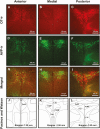Sex-specific Disruption of the Prairie Vole Hypothalamus by Developmental Exposure to a Flame Retardant Mixture
- PMID: 34038511
- PMCID: PMC8571712
- DOI: 10.1210/endocr/bqab100
Sex-specific Disruption of the Prairie Vole Hypothalamus by Developmental Exposure to a Flame Retardant Mixture
Abstract
Prevalence of neurodevelopmental disorders (NDDs) with social deficits is conspicuously rising, particularly in boys. Flame retardants (FRs) have long been associated with increased risk, and prior work by us and others in multiple species has shown that developmental exposure to the common FR mixture Firemaster 550 (FM 550) sex-specifically alters socioemotional behaviors including anxiety and pair bond formation. In rats, FRs have also been shown to impair aspects of osmoregulation. Because vasopressin (AVP) plays a role in both socioemotional behavior and osmotic balance we hypothesized that AVP and its related nonapeptide oxytocin (OT) would be vulnerable to developmental FM 550 exposure. We used the prairie vole (Microtus ochrogaste) to test this because it is spontaneously prosocial. Using siblings of prairie voles used in a prior study that assessed behavioral deficits resulting from developmental FM 550 exposure across 3 doses, here we tested the hypothesis that FM 550 sex-specifically alters AVP and OT neuronal populations in critical nuclei, such as the paraventricular nucleus (PVN), that coordinate those behaviors, as well as related dopaminergic (determined by tyrosine hydroxylase (TH) immunolabeling) populations. Exposed females had fewer AVP neurons in the anterior PVN and more A13 TH neurons in the zona incerta than controls. By contrast, in FM 550 males, A13 TH neuron numbers in the zona incerta were decreased but only in 1 dose group. These results expand on previous work showing evidence of endocrine disruption of OT/AVP pathways, including to subpopulations of PVN AVP neurons that coordinate osmoregulatory functions in the periphery.
Keywords: Social; anxiety; dopamine; endocrine disrupting chemicals; endocrine disruptors; neural; neurodevelopment; oxytocin; vasopressin.
© The Author(s) 2021. Published by Oxford University Press on behalf of the Endocrine Society. All rights reserved. For permissions, please e-mail: journals.permissions@oup.com.
Figures






References
-
- Dufour P, Charlier C. Brominated flame retardant: environmental and exposed individuals’ health impact. Ann Biol Clin (Paris). 2017;75(2):146-157. - PubMed
-
- Xiong P, Yan X, Zhu Q, et al. A review of environmental occurrence, fate, and toxicity of novel brominated flame retardants. Environ Sci Technol. 2019;53(23):13551-13569. - PubMed
-
- Landgraf R, Neumann ID. Vasopressin and oxytocin release within the brain: a dynamic concept of multiple and variable modes of neuropeptide communication. Front Neuroendocrinol. 2004;25(3-4):150-176. - PubMed
Publication types
MeSH terms
Substances
Grants and funding
LinkOut - more resources
Full Text Sources
Other Literature Sources
Miscellaneous

